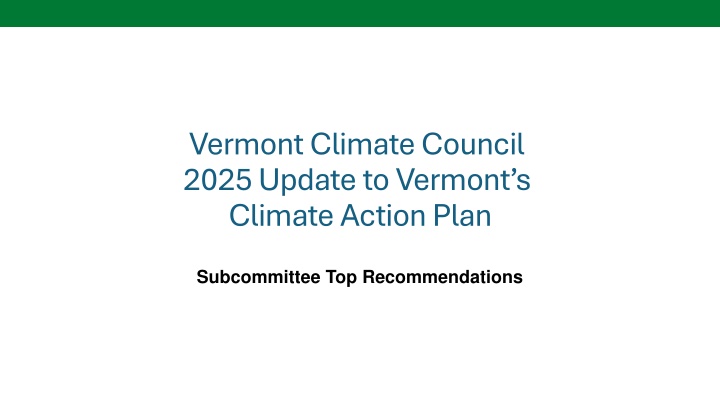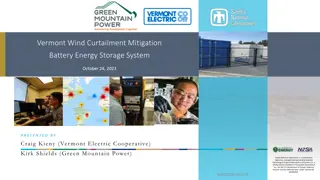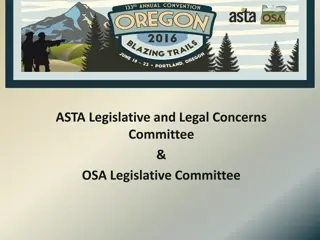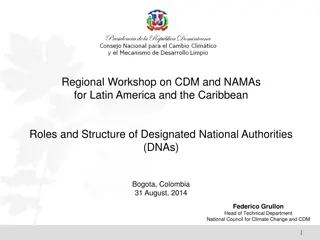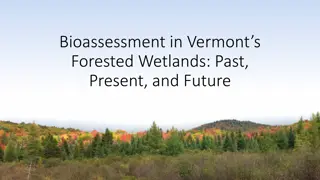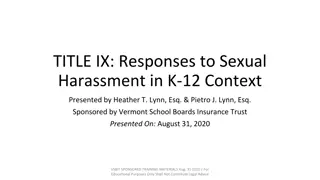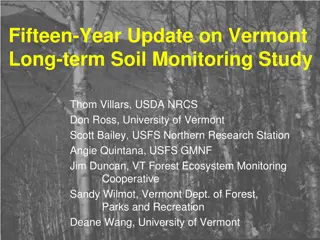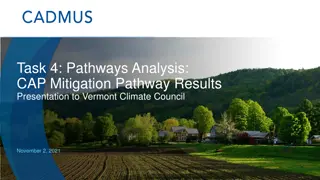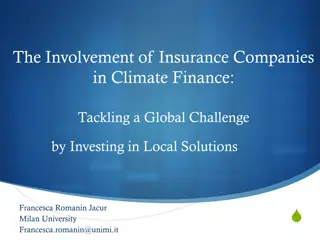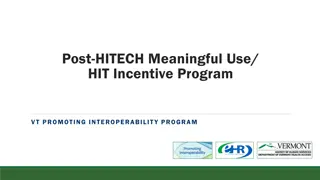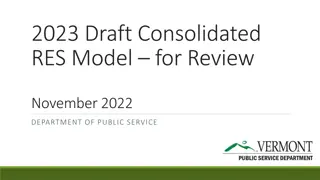Update on Vermont Climate Council 2025 Recommendations
The Rural Resilience & Adaptation Subcommittee emphasizes building resilience in communities, infrastructure, and public health to combat climate change effects. Pathways and strategies include increasing capacity for climate resilience planning, enhancing infrastructure resilience, and promoting equitable best practices in rural areas.
Download Presentation

Please find below an Image/Link to download the presentation.
The content on the website is provided AS IS for your information and personal use only. It may not be sold, licensed, or shared on other websites without obtaining consent from the author.If you encounter any issues during the download, it is possible that the publisher has removed the file from their server.
You are allowed to download the files provided on this website for personal or commercial use, subject to the condition that they are used lawfully. All files are the property of their respective owners.
The content on the website is provided AS IS for your information and personal use only. It may not be sold, licensed, or shared on other websites without obtaining consent from the author.
E N D
Presentation Transcript
Vermont Climate Council 2025 Update to Vermont s Climate Action Plan Subcommittee Top Recommendations
Rural Resilience and Adaptation Rural Resilience & Adaptation Subcommittee focuses on: Identifying, evaluating and analyzing existing and new strategies and programs that build resilience and prepare the State s communities, infrastructure, and economy to adapt to the current and anticipated effects of climate change. Core Focus Areas Community Capacity and Planning Infrastructure and the Built Environment Public Health
Overview of Pathways and Strategies Pathway 14: Increase capacity for climate resilience planning and implementation, and address inequities of under-resourced communities. 3 Strategies under this Pathway 12 Actions under this Pathway Pathway 15: Proactively and strategically invest to enhance resilience in transportation, communications, water/wastewater, and energy infrastructure and prioritize our most vulnerable communities and environmental- justice populations. 2 Strategies under this Pathway 16 Actions under this Pathway Pathway 16: Support the reduction of municipal, school district, residential, university, and hospital fossil fuel use in rural areas through equitable best practices that address the unique challenges of rural communities. Zero Strategies under this pathway as the Cross-Sector Mitigation SC took lead Actions addressing weatherization and electrification included in strategies 14a and 14d
Overview of Pathways and Strategies Pathway 17: Change Vermont's land-use policies so current and future land development will be adaptive and resilient to climate change impacts. 1 Strategies under this Pathway 0 Actions under this Pathway Pathway 18: Ensure that all people have access to safe, accessible, energy efficient, and affordable housing. 3 Strategies under this Pathway 10 actions under this Pathway Pathway 19: Provide for equitable adaptation to the public health impacts of climate change 4 strategies under this pathway 12 actions under this pathway
Secure sustainable, long-term funding to expand and maintain a permanent Flood Resilient Communities Fund (Community Resilience and Disaster Mitigation Fund) for the design and implementation of local and regional climate change adaptation projects and community resilience. Funding may be used as local match for federally funded hazard mitigation programs as well as non-FEMA eligible hazard mitigation activities. Community Capacity and Planning Priority Actions Establish permanent, dedicated funding for Regional Planning Commissions to hire and retain staff for climate resilience planning work, hazard mitigation application development, and management of hazard mitigation grants on behalf of municipalities or other eligible grant recipients as well as cover overhead costs related to completing Local Hazard Mitigation Plans. Map areas that are suitable for new, climate safe housing, set regional targets for new housing units created, and increase funding mechanisms where communities are investing in development-ready infrastructure. Create and facilitate a business support network that connects and engages all relevant organizations necessary to support business resilience and disaster response that builds off and supports structures that already exist such as Chambers of Commerce, Community Organizations Active in Disaster, Downtown Organizations, and Vermont Businesses for Social Responsibility. Increase State capacity to manage funding programs and provide technical assistance for the development and implementation of climate resilience plans, with a focus on maximizing the efficacy of Local Hazard Mitigation Plans, and augmenting existing programs with the Municipal Planning and Resilience Grant Program, the Municipal Climate Planning Framework and Guide, and the Municipal Climate Toolkit.
Infrastructure and the Built Environment Priority Actions Improve Municipal Vulnerability Index to be an index in addition to being an indicators tool so that it can be used to prioritize infrastructure investments across the state based on relative vulnerability. Infrastructure providers, working with stakeholders including regulatory agencies as appropriate, should assess vulnerabilities, adopt cost-benefit analysis methodologies, prioritize investments, and develop metrics and targets to measure progress. Replace aging electric and communication infrastructure with the most appropriate resilient alternative when cost effective. In the absence of and/or in addition to dedicated federal funding, create a dedicated transportation flood resilience funding program to proactively address identified transportation risks and vulnerabilities. Provide a sustainable funding source for addressing drinking water, stormwater, and wastewater infrastructure vulnerabilities identified and prioritized through asset management plan and vulnerability assessments development.
Public Health Priority Actions Provide funding for resilience equipment, supplies, and services that help reduce the health impact of climate-related hazards for income-qualifying households needing extra assistance. Increase funding for state-contracted community mental health services, to provide funded partners with more capacity to address anxiety, depression, distress, and trauma caused by climate change and climate-related disasters. Provide funding and technical assistance to municipalities and local organizations to reduce health impacts of climate change for the disproportionately affected populations they serve, through preparedness, facility adaptation, and support for individuals and households. Explore and implement strategies to enhance local emergency preparedness, response, and recovery capacity (e.g., expand funding and authority of RPCs and/or county government; increase direct state funding, training, and technical assistance to municipalities). Provide funding and technical assistance to local partners to develop community resilience hubs that can serve as places for learning, collaboration, resource access, and refuge in response to climate-related hazards and other community needs.
